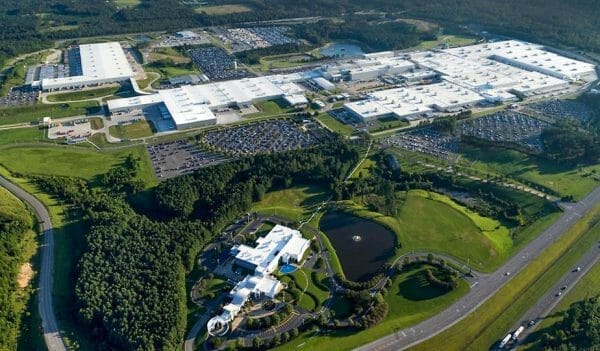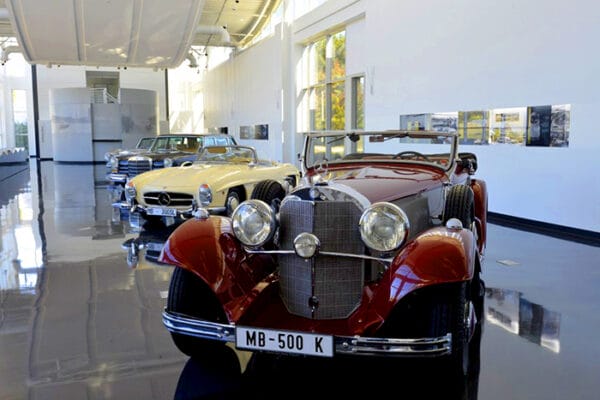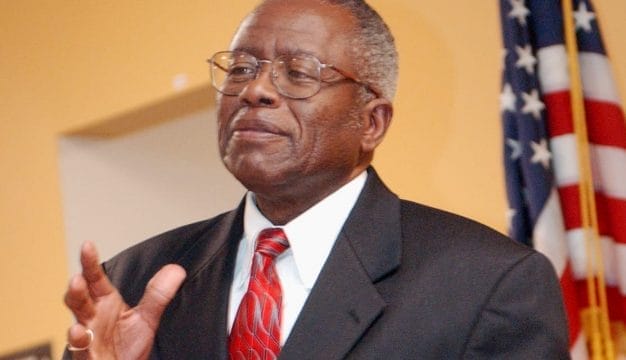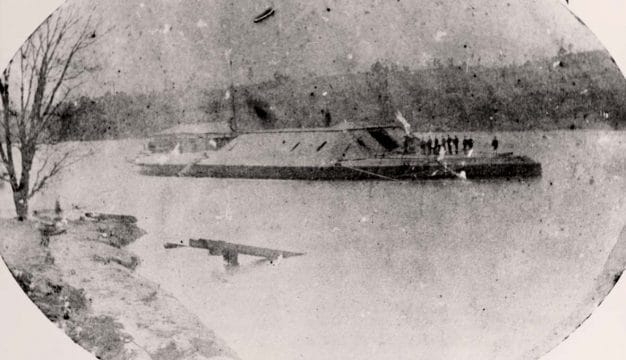Mercedes-Benz U.S. International Inc.
Located in Vance, Tuscaloosa County, Mercedes-Benz U.S. International Inc. (MBUSI) was the first-ever automobile manufacturing facility established in Alabama and the firm’s first in the United States. MBUSI employs about 4,000 individuals, has created thousands of additional jobs in associated industries, and has contributed more than $1.5 billion to the Alabama economy each year since vehicle production began in 1997. Initially the facility produced only one model, the M-Class sport utility vehicle (SUV). However, as a result of the international success of this model, the company doubled the size of the Vance plant in 2004 and began producing two additional models, the R-Class Grand Sports Tourer and the GL-Class luxury SUV.
 Mercedes-Benz Production Line
Mercedes’s decision to build its first manufacturing facility for passenger vehicles outside of Germany, announced in April 1993, was prompted by the company’s globalization strategy and a need to move closer to its customers and markets. An intensive site selection process helped the company identify 100 sites in 35 states. After considering transportation costs and the age distribution and mix of skilled and unskilled workers, the potential sites were narrowed down to three finalists: Alabama, North Carolina, and South Carolina. Determined to host Mercedes, Alabama state and local officials offered the company approximately $250 to $300 million in incentives, primarily consisting of the deferral of taxes. Critics complained that the tax deferments deprived local schools of needed funding and were unnecessary, and leaders of established local industries complained that new businesses such as Mercedes were given advantages that they had not received. Mercedes executives argued that if they had not decided to locate in Alabama, the tax base never would have been created in the first place. Despite the criticisms, the company announced in September 1993 that it would build its first American plant in Vance. Gov. Jim Folsom believed that having a luxury carmaker locate in the state would help improve the sometimes negative images associated with the state.
Mercedes-Benz Production Line
Mercedes’s decision to build its first manufacturing facility for passenger vehicles outside of Germany, announced in April 1993, was prompted by the company’s globalization strategy and a need to move closer to its customers and markets. An intensive site selection process helped the company identify 100 sites in 35 states. After considering transportation costs and the age distribution and mix of skilled and unskilled workers, the potential sites were narrowed down to three finalists: Alabama, North Carolina, and South Carolina. Determined to host Mercedes, Alabama state and local officials offered the company approximately $250 to $300 million in incentives, primarily consisting of the deferral of taxes. Critics complained that the tax deferments deprived local schools of needed funding and were unnecessary, and leaders of established local industries complained that new businesses such as Mercedes were given advantages that they had not received. Mercedes executives argued that if they had not decided to locate in Alabama, the tax base never would have been created in the first place. Despite the criticisms, the company announced in September 1993 that it would build its first American plant in Vance. Gov. Jim Folsom believed that having a luxury carmaker locate in the state would help improve the sometimes negative images associated with the state.
 Mercedes Plant in Vance
Construction of the $300 million plant in Vance was completed in July 1996, production began in January 1997, and the first M-Class models were produced eight months later, the first automobiles manufactured in Alabama. MBUSI initially projected building 65,000 M-Class vehicles each year. However, the vehicle’s popularity prompted the company to invest an additional $80 million in 1998 and 1999 to expand the facility and increase production to 80,000 vehicles per year. During MBUSI’s first eight years in Alabama, two shifts of workers produced 350 vehicles each day. As a result of the success of the M-Class, MBUSI invested another $600 million in the Vance facility beginning in 2004, doubling its annual production capacity to 160,000 vehicles, increasing the workforce to 4,000 employees, and adding the R-Class Grand Sports Tourer and the GL-Class luxury SUV to the lines produced there. The 3.2 million square-foot facility measures almost one mile from end to end and includes two assembly lines, two paint shops, one body shop, and administrative offices. In addition, the plant has a visitor center, a training facility, and a childcare and wellness center.
Mercedes Plant in Vance
Construction of the $300 million plant in Vance was completed in July 1996, production began in January 1997, and the first M-Class models were produced eight months later, the first automobiles manufactured in Alabama. MBUSI initially projected building 65,000 M-Class vehicles each year. However, the vehicle’s popularity prompted the company to invest an additional $80 million in 1998 and 1999 to expand the facility and increase production to 80,000 vehicles per year. During MBUSI’s first eight years in Alabama, two shifts of workers produced 350 vehicles each day. As a result of the success of the M-Class, MBUSI invested another $600 million in the Vance facility beginning in 2004, doubling its annual production capacity to 160,000 vehicles, increasing the workforce to 4,000 employees, and adding the R-Class Grand Sports Tourer and the GL-Class luxury SUV to the lines produced there. The 3.2 million square-foot facility measures almost one mile from end to end and includes two assembly lines, two paint shops, one body shop, and administrative offices. In addition, the plant has a visitor center, a training facility, and a childcare and wellness center.
In addition to the 4,000 direct jobs it created in the Vance plant, MBUSI claims to have been the catalyst for the gradual development of more than 18,000 indirect jobs in the region and an annual economic impact of $1.5 billion in the state. Approximately 30 businesses that supply automotive components for MBUSI-built vehicles are currently located in Alabama, including Brose Tuscaloosa, Inc., a German-based company located in Vance, which supplies door systems and Johnson Controls Inc. in Cottondale, which supplies automotive seating and interior product lines. Additionally, MBSUI is Alabama’s leading exporter, with more than $1 billion in exports per year to 135 countries throughout the world. In 2008, an industry-wide downturn in sales caused by a global financial crisis forced overseas sales down. To compensate, MBUSI laid off temporary workers, eliminated Friday shifts, offered buyouts to its employees, and extended the plant’s usual two-week winter shutdown to a month.
 Mercedes-Benz Visitors Center
MBUSI’s overall success opened the door for the automobile industry to further expand into Alabama. In 1999, Honda chose St. Clair County as the location of a plant for manufacturing its Odyssey minivan, and in 2002 Hyundai chose Montgomery County as the site of its first U.S. automotive manufacturing facility. Two major engine plants, Navistar International Corporation and Toyota Motor Manufacturing Alabama, also have located in the state, both in Madison County.
Mercedes-Benz Visitors Center
MBUSI’s overall success opened the door for the automobile industry to further expand into Alabama. In 1999, Honda chose St. Clair County as the location of a plant for manufacturing its Odyssey minivan, and in 2002 Hyundai chose Montgomery County as the site of its first U.S. automotive manufacturing facility. Two major engine plants, Navistar International Corporation and Toyota Motor Manufacturing Alabama, also have located in the state, both in Madison County.
In December 2009, MBUSI announced that production of its popular C-Class sedan will be transferred, over angry protests from German auto workers, from its Sindelfingen plant in Germany to its facility in Vance in 2014. Company officials estimate that this move will result in the addition of approximately 1,000 more jobs at the Alabama factory and is also expected to increase associated business both within the state and the region. The expansion was once again supported by a generous tax incentives package from state and local governments totaling $100 million.
Further Reading
- Haasen, Adolf. New Corporate Cultures that Motivate. Westport, Connecticut: Greenwood Publishing Group, 2003.
- Flynt, Wayne. Alabama in the Twentieth Century. Tuscaloosa, Alabama: University of Alabama Press, 2004.
- Fry, Earl H. The Expanding Role of State and Local Governments in U.S. Foreign Affairs. Washington, D.C.: Council on Foreign Relations, 1998.
- O’Donnell, Joe. The Forge, Metal to Medicine: Birmingham’s Business History. Birmingham, Alabama: Birmingham Regional Chamber of Commerce, 2007.



